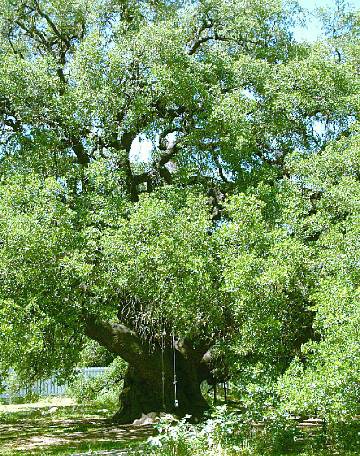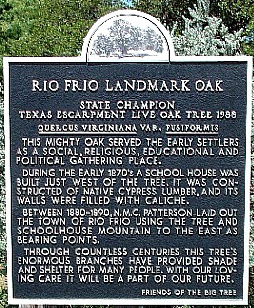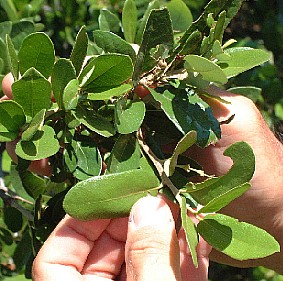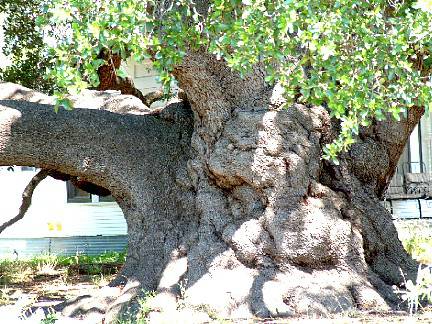
by species —
by state —
by size —
by height

|
National Champion
Texas Live Oak
Quercus virginiana var. fusiformis
Beech Family
— Oak Genus
Rio Frio, Real County, Texas
Circumference = 295 inches (24.58 feet)
Height = 42 feet
Average Crown Spread = 98 feet
Total Points = 362
Nominated: 1999
by: LeAnn Walker
Cloned: July 2001
by: Terry Mock & Jared Milarch
|
|---|

The Texas Live Oak, also called Evergreen Oak, is a large, spreading tree of the white oak
group, with short, broad trunk buttressed at the base, forking into
nearly horizontal, long branches, and very broad, spreading, dense
crown. It is common to central Texas, and local to southwest Oklahoma
and northeast Mexico. It is distinguished from the Live Oak by slightly smaller leaves, broadest at the base, and acorns with cups narrowed at the base.
It normally grows in low,
sandy soils near the coast, but also occurs in moist, rich woods and
along stream banks. This handsome tree is very popular throughout the
Southeast as a shade tree. Live oaks are often planted in cities, but
should be restricted to large yards or parks where their wide-spreading
form can be accomodated.

On the Gulf Coast, live oaks often
support many types of epiphytic plants, including Spanish moss, which
hangs in weeping festoons. Live oak is usually grows in association
with several other hardwoods, including winter oak, laurel oak,
sweetgum, southern magnolia, and American holly.
A fast-growing tree, the
live oak flowers in early spring (usually in March or April), and the
acorns mature in September or October. Sweet edible acorns are usually
produced in great abundance, and are of great value to many birds and
mammals, including wild turkeys, wood ducks, jays, quail, whitetail
deer, raccoons, and squirrels.
The yellowish-brown wood
is hard, heavy, tough, strong, and is used for structural beams, ship
building, posts, and in places requiring strength and durability. The
nation's first publicly-owned timber lands were purchased in 1799 to
preserve these trees for use in shipbuilding. It ranks as the heaviest
native hardwood, weighing 55 pounds per cubic foot when air dry. This
weight (density of mass) makes the live oak the premier fuel wood.

Identification
Size: medium-size tree up to 70 feet high with wide-spreading, rounded crown
Range: coastal areas from southeast Virginia south to southern Florida, and west to southeast Texas

Habitat is low, sandy areas near the coast, but also moist, rich woods and along streams
Leaves
are alternate, evergreen, thick, leathery, elliptical and oblong, 1.5
to 5 inches long, .4 to 2.5 inches wide, dark green and shiny above,
pale and hairy underneath, edges usually straight and slightly rolled
under, variable in shape, widest near or above the middle to uniformly
broad, tapering to rounded at the base, rounded to short-pointed at the
tip, usually entire or slightly wavy along the margin, occasionally
with a few teeth; shedding after new leaves appear in spring.
Flowers
appear early in spring, male and female in separate catkins, on
branchlets of the current year; male flowers custered on hanging, hairy
catkins 2 to 3 inches long

Fruit
is an acorn, dark brown, shiny, sweet, edible, maturing in one season
on current year's branchlets, solitary to few-clustered, stalked .8 to
one inch, broadest at the base to almost uniformly wide, rounded to
pointed at the tip; cup enclosing one-fourth of the nut, .6 to .8 inch
across, scales thin, overlapping, broadest at base, pointed at tip,
covered with dense hairs
Bark is thick, .5 to one inch, dark brown to dark reddish-brown, shallowly furrowed, forming small, closely pressed scales
Branches are stout, spreading; branchlets slender, hairy when young, becoming smooth and gray to brown with age
Buds are .1 to .2 inches long, globe-shaped to widest near the base, covered with overlapping light, chestnut-brown scales
Wood is yellowish-brown, hard, heavy, tough, strong, and used for structural beams, ship building, posts
Similar Species: Any kind of evergreen oak can be called "live oak," including Live Oak, Coast Live Oak, Sand Live Oak

Culture
Soils:
Seedlings:
Saplings:
Special:
Problems:
Cultivars:
Related Species: Live Oak, Coast Live Oak, Sand Live Oak


TERRA: The Earth Restoration and Reforestation Alliance —
www.championtrees.org —
updated 8/14/2003




